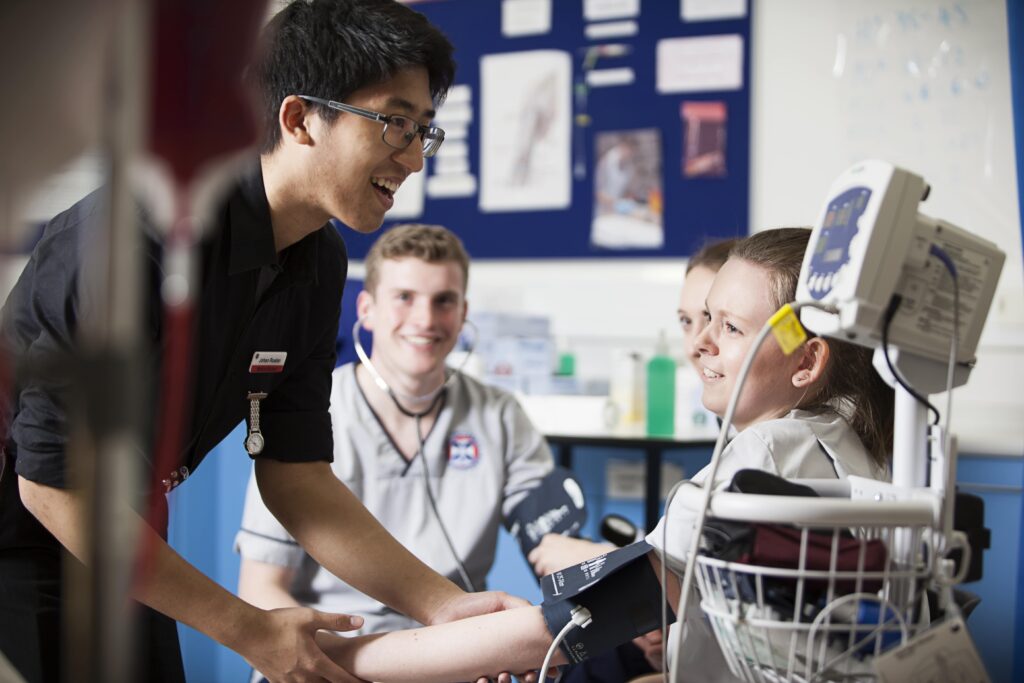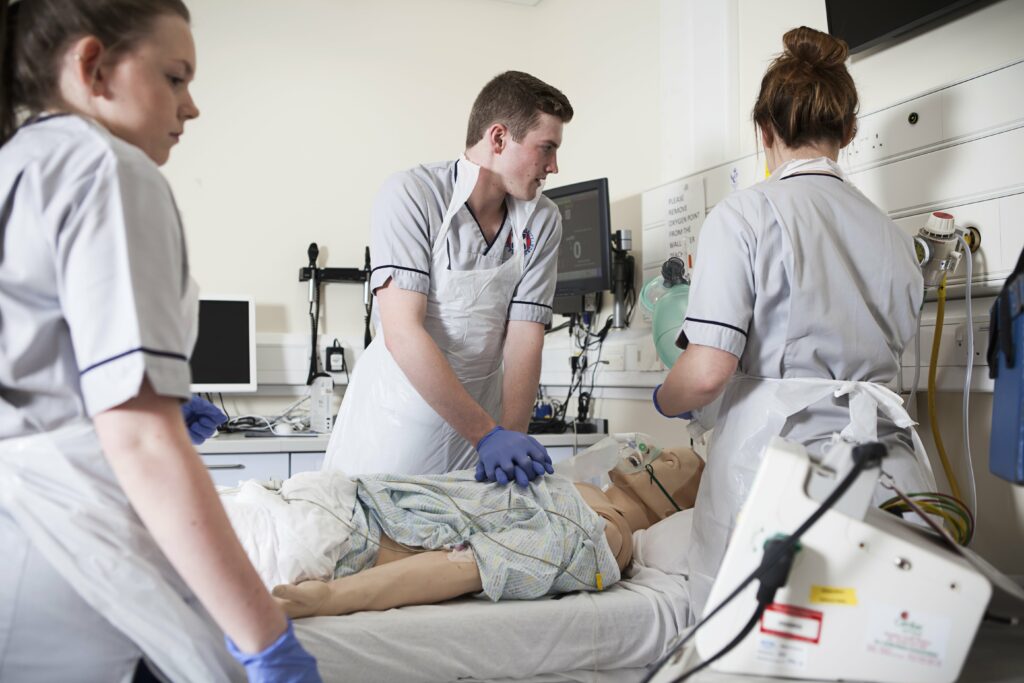
Physiology News Magazine
Crossing the barriers in health care education
Membership
Crossing the barriers in health care education
Membership
Dr Alison Wood, Lecturer in Nursing, Division of Nursing, Queen Margaret University, UK
Dr Colin Chandler, Lecturer in Life Science, Nursing Studies, University of Edinburgh, UK
https://doi.org/10.36866/122.42
A knowledge of the biosciences, and physiology in particular, underpins practice in many healthcare areas. How as physiologists can we support this area of learning and what is needed to support healthcare practitioners in their pre- registration learning, ongoing CPD and advanced professional learning (1)?
As part of a David Jordan Teaching Award, an opportunity to meet with other nurse educators and discuss the complex topic of physiology within the nurse education curriculum was welcomed. Eight educators met to
thrash out the start of a physiology curriculum; however, in doing so we also shared the challenges we face when embedding these into a course or programme.
The purpose of this study was to provide guidance to educators, reduce variability, and set a benchmark in terms of level and breadth for the foundational physiological knowledge that supports professional development and safe patient care.
However, it is clear that within pre- registration nurse education (degree level leading to professional registration), and other allied health degrees, the time allowed for physiology alongside other biosciences continues to be low. For some nurse programmes, as little as 200 notional equivalent study hours within a nursing degree for all biosciences (10 European Credit Transfer System (ECTS) credits or just over 5% of a three-year degree).

Physiology learning outcomes for nurses
The project funded by The Physiological Society provided a clear definition of the relevant physiological knowledge that is required by nurses to support their clinical practice at registration and completion of their degree.
This consensus-driven identification of 177 core learning outcomes were developed to define the key physiological concepts on which nurses will build throughout their future careers and professional development (2).
These core outcomes are needed as nurses (and healthcare professionals) need to be able to articulate to colleagues, individuals and families what is going on in front of them when caring for an unwell individual and their families. This can be particularly important in times of remote working, in online and telephone consultations, where the nurse is providing care with or without direct support.
This work parallels other initiatives looking at healthcare curriculums including The Physiological Society’s own physiology curriculum for medical students, and in other disciplines such as anatomy (3,4).
To see the importance of physiology underpinning the curriculum let’s consider some clinical scenarios to show why physiology concepts are key.
Many practitioners qualifying at degree level or higher are not trained as academic scientists, but as users of knowledge to understand and support their practice. They need to be able to communicate to their patients and their families what is happening to enable informed and shared decision making on their care.
The COVID-19 pandemic has highlighted that nurses, alongside other allied health professionals, are key to patient care, safety and in maintaining NHS services. Staff being redeployed to intensive care units from various parts of the health service highlight the need for nurse degree education to ensure a foundation of core concepts including physiology.

Working together
Interacting with these professional groups is an exciting and educative experience for a physiologist. The students bring experience, insights, and questions from practice, but some barriers exist in this collaboration.
Our different disciplines may not share the same language; even the same words may have different meaning in the different contexts. This requires a mutual respect and ongoing dialogue to resolve confusion.
As adult learners, students bring their experience into the setting and this needs to be used as a resource and clinical context to the topic; they are ready to learn and enthusiastic but need to be able to see the relevance and application of their learning.
One of the real challenges for educators within the healthcare professions is the variation of education level at the beginning of their healthcare degree. We are sure readers of Physiology News would agree that it is key to have the physiology principles of good health as an early part of a degree so that students can then understand as they progress and develop the principles of ill health or disease. When faced with a class of new students, all enthusiastic but some having very little science knowledge already in their arsenal, how can we as educators take all the students with us on this journey through physiology?
For many learners the challenge may be to engage with the initial scientific concepts that can open the door to greater understanding. Supporting learners to cross these threshold concepts is both a challenging and rewarding aspect of working across the scientific and clinical disciplines.
Healthcare, like physiology, does not stand still in its knowledge base but is continually developing. Often it is more important to understand and grasp the fundamental concepts, as a platform to fit specific and relevant new information. This also acts as a basis for future learning and understanding as knowledge develops in their practice.

Moving forward in collaboration
This past year has been one of rapid adaptation both in academia and in healthcare practice. Redeployment to areas of high need has been common in healthcare, and a shift from face-to-face teaching to online delivery in academia has happened.
These have presented challenges and opportunities. As we emerge from the pandemic this is a great time to think about how we can develop and support practice learning in new ways. Can we engage practitioners at all levels in learning using many of the resources we have developed over the last year? To summarise, the of opportunities for physiologists to engage with healthcare professionals, both students and practitioners, by identifying real-world practice issues that are being faced and generating new questions that can lead to new areas of research.
This requires an open mind, willingness to engage in conversations and different disciplinary approaches. It requires a recognition that healthcare is person- centred, as individuals or patients are of key importance in decision making and engagement, and it is their lives on the line and their healthcare experience.
We also need to understand how people use and learn from online material. It is best delivered in small chunks, related to practice and engaging with student experience.
Can we share resources that are under Creative Commons licences, such as: lectures (recorded – preferably short and engaging), animations, activities, practicals, virtual reality (VR) resources, or clinical scenarios and case-based discussions.
The recent events and changes to how we as practitioners and educators engage with learning and learners have provided us with an opportunity to relook at what we do and how we should do this better in the future.
Collaborative working of physiologists and healthcare educators and learners can provide a wealth of opportunities. It can be a great way to bring your science to life, relating it to the real world of healthcare and demonstrating its impact to the wider public.
References
- By healthcare professionals we mean medical practitioners, nurses and midwives, pharmacists, physiotherapists, occupational therapists, dieticians, paramedics and other therapists registered with the Health and Care Professional Council (HCPC).
- Wood A et al. (2020). Designing and developing core physiology learning outcomes for pre-registration nursing education curriculum. Advances in Physiology Education 44(3), 464–474. https://doi.org/10.1152/advan.00139.2019
- Physiological Objectives for Medical Students; Medical-curriculum.pdf (physoc.org)
- Connolly SA et al. (2018). The Anatomical Society’s core anatomy syllabus for undergraduate nursing. Journal of Anatomy 232(5), 721–728. https://doi.org/10.1111/joa.12782
